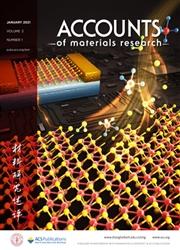Regulating Circularly Polarized Luminescence in Zero-Dimensional Chiral Hybrid Metal Halides
IF 14.7
Q1 CHEMISTRY, MULTIDISCIPLINARY
引用次数: 0
Abstract
Polarization reflects the inherent properties of light. Circularly polarized light, in which the electric field rotates in a circle along the direction of propagation, contains rich optical information and exhibits angle-independent characteristics. This feature makes it widely applicable in asymmetric synthesis, 3D display, and light-emitting devices. Research on circularly polarized luminescence (CPL) has garnered significant attention in recent years. CPL-active materials range from small molecules to supermolecules and from chiral rare-earth complexes to nanosuperstructures. With advancements in developing new materials and technology in chiral science, this field has rapidly developed, and extensive efforts are focused on the development of CPL-active materials with both high photoluminescence quantum yield (PLQY) and large luminescence dissymmetry factor (glum). Among these materials, zero-dimensional (0D) chiral hybrid metal halides (CHMHs) characterized by isolated inorganic polyhedra, which combine the chirality of organic cations with excellent photophysical properties of inorganic polyhedra, have emerged as a promising class of CPL-active materials. Despite recent advancements in the design and preparation of CPL-active 0D CHMHs, several challenges remain. Considering the demands of real applications, high PLQY, large glum value, and a range of CPL colors are all required.

零维手性杂化金属卤化物圆偏振发光的调控
偏振反映了光的固有特性。圆偏振光是电场沿传播方向作圆周旋转的光,具有丰富的光学信息和与角度无关的特性。这一特性使其广泛应用于不对称合成、三维显示和发光器件。圆偏振光的研究近年来引起了广泛的关注。cpld活性材料的范围从小分子到超分子,从手性稀土配合物到纳米超结构。随着手性科学新材料和新技术的发展,这一领域得到了迅速发展,人们广泛致力于开发具有高光致发光量子产率(PLQY)和大发光不对称因子(glum)的cpll活性材料。其中,以分离的无机多面体为特征的零维手性杂化金属卤化物(CHMHs)结合了有机阳离子的手性和无机多面体优异的光物理性质,成为一类很有前途的cpld活性材料。尽管最近在设计和制备cpll活性0D chmh方面取得了进展,但仍然存在一些挑战。考虑到实际应用的需求,高PLQY,大胶值,CPL颜色范围都是必需的。
本文章由计算机程序翻译,如有差异,请以英文原文为准。
求助全文
约1分钟内获得全文
求助全文

 求助内容:
求助内容: 应助结果提醒方式:
应助结果提醒方式:


